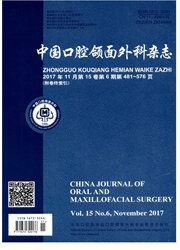

 中文摘要:
中文摘要:
目的:介绍一种兔血管化面神经移植动物模型建立的方法。方法:选用15只新西兰白兔,带动静脉血管蒂的耳大神经移植组6只.行血管化神经移植修复面神经缺损:游离耳大神经移植组6只,行游离神经移植修复面神经缺损:空白组3只,面神经缺损后不行修复。术后第1、4个月,分别观察兔面部形态的变化,术后4个月行面神经电生理检测.处死后取面神经移植段标本作病理学、免疫组织化学等检测,应用SPSS13.0软件包对数据进行统计学分析。结果:面神经移植术后,兔手术侧上唇形态及功能均有一定恢复,血管化神经移植组的结果均优于对照组。在神经移植段内均可见轴突再生.良好的血供促进轴突再生。结论:本实验提供了一种操作容易、稳定可靠的兔血管化面神经移植模型.对面神经移植修复的研究有一定价值。
 英文摘要:
英文摘要:
PURPOSE: To develop a new vascularized nerve graft model for facial nerve repair. METHODS: Fifteen New Zealand white rabbits were used in this study. The great auricular nerve of ear was designed as a vascularized graft to serve as a model. VNG group (n=6) received vascularized facial nerve graft, FNG group (n=6) received free nerve graft, control group (n=3) were blank rabbits. The results were evaluated with analysis of facial performance, histological and immunohistochemical studies and electrophysiological monitoring. SPSS 13.0 software package was used for data analysis. RESULTS: At 4-month following facial nerve repair, facial nerve function recovery was observed and analyzed, VNG group was better than FNG group. Through the 20mm facial nerve graft, regenerated nerve fibers were seen, good vascularation facilitated more axons regeneration. CONCLUSIONS: This study demonstrates a new feasibility of vaseularized nerve graft in a rabbit model. It has obvious operability and reliability compared with the other models, and the model is useful for future investigation in facial nerve repair.
 同期刊论文项目
同期刊论文项目
 同项目期刊论文
同项目期刊论文
 期刊信息
期刊信息
